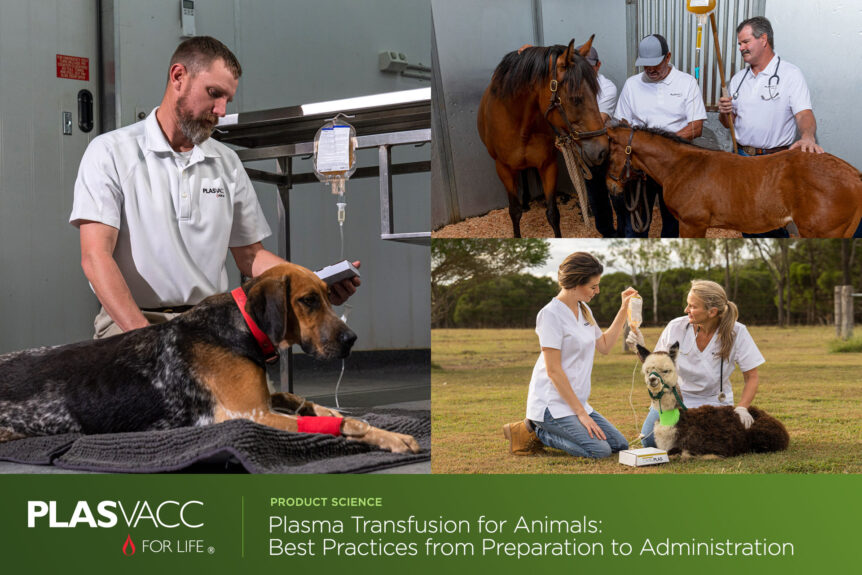Plasma transfusion for animals is a proven therapeutic tool in modern veterinary medicine. From neonatal foals with Failure of Passive Transfer (FPT) to adult dogs recovering from trauma, plasma delivers life-saving antibodies and proteins that support the immune system and speed up recovery.
But the power of plasma isn’t just in what is in the bag—it’s in how it’s handled. This guide outlines best practices to help veterinary professionals administer plasma and maximize the effectiveness of every transfusion.
Why Use Plasma in Veterinary Care?
Plasma isn’t just a treatment. It is also a preventative tool for immunocompromised animals. Whether you are treating neonate or adult patients, plasma transfusions offer targeted support where it’s needed most.
- Failure of Passive Transfer (FPT) or partial FPT
- Gastrointestinal illness and disease: parvovirus, diarrhea, colitis, pancreatitis
- Severe infections and surgery
- Pneumonia and other respiratory infections
- Any condition with depleted gamma globulins
Before You Begin: Read the Instructions
NOTE: Plasma transfusions must be performed by licensed veterinarians.
Before thawing or administering plasma, always read the full product label and dosage instructions. Equiplas® and Caniplas® come with detailed instructions that are critical for safe and effective use.
Download Product Info Sheet: Equiplas® | Download Product Info Sheet: Caniplas®
Thawing Plasma the Right Way
Improper thawing is one of the most common errors in plasma administration, yet one of the easiest to avoid. Plasma must be brought to body temperature in a controlled water bath. Water that is too hot can activate fibrinogen and cause the plasma to clot. Thawing plasma too slowly or in water that is too cold can cause cryoprecipitates to appear, which dissipate when brought to body temperature.
- Keep plasma frozen until you’re ready to thaw and administer.
- Fill a sink or water bath with water that is 40°-45°C Use a thermometer.
- Place the plasma bag in the water so it floats freely.
- Never use direct heat(e.g., microwaves, heating elements, or tap water over 45°C).
- If you need to add more hot water, remove the bag first to avoid thermal damage. Avoid hot water from the faucet coming into direct contact with the bag of plasma.
- Thawing typically takes 10–20 minutes.
Need more guidance? Visit Plasvacc’s Thawing Instructions.
Administering Plasma
Plasma is administered intravenously using a blood administration set with a 200-micron filter. This helps prevent particles from entering the bloodstream and ensures smooth delivery. After warming to body temperature, mix well and administer directly from the bag. Nothing should be added to the contents of the bag, and the plasma must not be removed from the bag and placed into another receptacle.
- Do not dilute plasma
- Use sterile, single-use administration sets and catheters
- Monitor for any adverse reactions (though extremely rare, they can occur)
- Have a second administration set ready in case of clogging
- Administer at a consistent IV rate
Storage and Inventory Tips for Clinics
Plasma from Plasvacc can be stored frozen for up to three years, providing the capability and ease of keeping plasma on hand at all times.
- Freezer temperature should be maintained between –17°C and –40°C
- Create a written protocol for thawing and administration (or use our checklist below)
- Train and refresh staff regularly (especially before busy seasons)
- Rotate stock regularly
Plasma Transfusion Checklist
Use this quick checklist to streamline plasma transfusion prep and ensure safe administration:
☐ Confirm product is the correct one for intended use
☐ Review dosage and administration instructions on label
☐ Fill water bath with 40–45°C water and place thermometer in water bath
☐ Thaw plasma (10–20 minutes) without direct heat
☐ Use 200-micron filtered blood administration set
☐ Monitor patient during administration
☐ Keep extra blood filtered administration set available
☐ Document serial number of plasma administered
Final Thoughts: Safe Plasma Transfusions Start with Good Habits
Plasma transfusions in animals are reliable and effective treatments, but only when conducted correctly. By following the storage and thawing protocols, using the proper equipment, and training your team, you can ensure each transfusion delivers maximum benefit to your patients.
Need help preparing for your next plasma transfusion? Check out our Knowledge Center for videos covering every aspect of plasma administration and storage. Our team is here to help you with product selection, technical support, and overnight shipping logistics. Contact us today.

